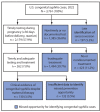Vital Signs: Missed Opportunities for Preventing Congenital Syphilis - United States, 2022
- PMID: 37971936
- PMCID: PMC10684351
- DOI: 10.15585/mmwr.mm7246e1
Vital Signs: Missed Opportunities for Preventing Congenital Syphilis - United States, 2022
Abstract
Introduction: Congenital syphilis cases in the United States increased 755% during 2012-2021. Syphilis during pregnancy can lead to stillbirth, miscarriage, infant death, and maternal and infant morbidity; these outcomes can be prevented through appropriate screening and treatment.
Methods: A cascading framework was used to identify and classify missed opportunities to prevent congenital syphilis among cases reported to CDC in 2022 through the National Notifiable Diseases Surveillance System. Data on testing and treatment during pregnancy and clinical manifestations present in the newborn were used to identify missed opportunities to prevent congenital syphilis.
Results: In 2022, a total of 3,761 cases of congenital syphilis in the United States were reported to CDC, including 231 (6%) stillbirths and 51 (1%) infant deaths. Lack of timely testing and adequate treatment during pregnancy contributed to 88% of cases of congenital syphilis. Testing and treatment gaps were present in the majority of cases across all races, ethnicities, and U.S. Census Bureau regions.
Conclusions and implications for public health practice: Addressing missed opportunities for prevention, primarily timely testing and appropriate treatment of syphilis during pregnancy, is important for reversing congenital syphilis trends in the United States. Implementing tailored strategies addressing missed opportunities at the local and national levels could substantially reduce congenital syphilis.
Conflict of interest statement
All authors have completed and submitted the International Committee of Medical Journal Editors form for disclosure of potential conflicts of interest. No potential conflicts of interest were disclosed.
Figures


References
-
- CDC. HIV: HIV surveillance report. Atlanta, GA: US Department of Health and Human Services, CDC; 2021. Accessed August 15, 2023. https://www.cdc.gov/hiv/library/reports/hiv-surveillance.html
-
- CDC. Viral hepatitis: 2020 viral hepatitis surveillance report. Atlanta, GA: US Department of Health and Human Services, CDC; 2022. Accessed August 15, 2023. https://www.cdc.gov/hepatitis/statistics/2020surveillance/index.htm
-
- CDC. Sexually transmitted disease surveillance 2021. Atlanta, GA: US Department of Health and Human Services, CDC; 2023. Accessed August 15, 2023. https://www.cdc.gov/std/statistics/2021/default.htm
MeSH terms
LinkOut - more resources
Full Text Sources
Medical

